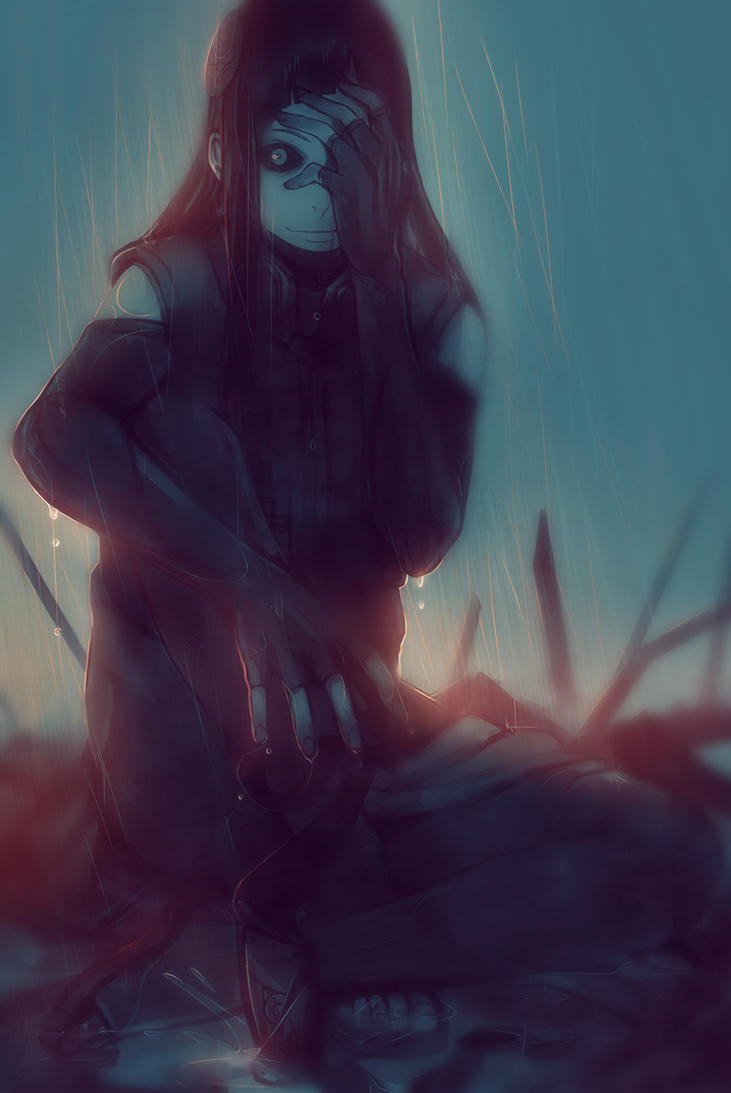The timeline begins where Naruto and Sasuke together managed to defeat the Otsutsuki threat, defeating Kaguya and effectively ending the war. Tsunade resigns as Hokage, Kakashi takes up the mantle and continues to foster the networks that Naruto had built. Once Naruto becomes Hokage, the Shinobi world experiences their 'golden age' or 'dark age' depending on who you ask. The times were peaceful, there was no major incidents and even small scale skirmishes and conflicts were quickly and easily resolved. Gradually all Great Shinobi Nations increased their dedication and commitment to the union of shinobi nations, though all of them remained sceptical.
Following Naruto's passing, and the disappearance of Sasuke, a new hokage was elected. A man of the Shimura clan, namely Genji Shimura, and thus relative of the late Danzou Shimura, creator of the ROOT foundation, took over this mantle under the promise of 'righting the wrongs of previous generations,' something commonly understood to mean the wrongs of his ancestor, Danzou Shimura.
Opposite to that, Genji Shimura slowly dialed back the commitments to the union of villages, causing the union to become more unstable. As the union had decreased competition between the various shinobi nations, there was a severe lack in issues that needed shinobi to be resolved, and thus a lack of clientele and jobs for the villages. Genji had hoped that through slowly pulling back from the union he could diminish these effects and gain back some work opportunities.
It was not, however, Genji Shimura that broke the pact. Following the death of Naruto, Raikage A from Kumogakure saw the direction Konohagakure was going in, and saw the storm hanging overhead. With no sociable and likeable characters like Naruto in leadership positions, A withdrew from the union entirely, claiming that Kumogakure was the strongest of all villages and had a right to self determination.
This caused the other villages to also withdraw, and signalled the end of the union of villages and was a prelude to the war that would come. Although it A never lived long enough to see the dawn of war, he lived long enough to see the chaos he'd sown, perhaps intentionally, and when he passed, his last words imparted on Killer Bee the wisdom to leave Kumogakure - words that Killer Bee did not heed.
The new Raikage was a shinobi by the name of Hamda, soon renamed to A. His first act as the new Raikage was the assassination of Killer Bee and the order to capture the Eight Tails and transplant it into his own body. With Killer Bee dead, the Eight Tails went on a rampage and destroyed the shinobi that were meant to capture him, before escaping into the ocean. It was said that the shockwaves of his plunge into the water could be felt in the Kirigakure harbour.
Following the disastrous attempt of capturing the Eight Tails, Hamda blamed Kirigakure for the failure and accused them of sending ANBU to steal the Eight Tails. Whether it was true or not, war was declared and within two days of the declaration of war, Kirigakure and Kumogakure forces clashed on the border.
Citing the former union of shinobi villages, Kirigakure called on Konohagakure, Sunagakure and Iwagakure for aid in the war. Sunagakure declined the call to arms on the basis that they could not fund a war at that very moment but promised the delivery of a shipment of weapons. Iwagakure did not wish to anger their militarily superior neighbors and declined the call to arms, proclaiming that the union of shinobi nations was no more and that they thus had no obligation to help. Konohagakure accepted the call to arms, however, but it was quickly proven that this was merely a symbolic show of support to the nation of Kirigakure as no Konohagakure forces fought Kumogakure forces during this war.
The war never reached a conclusion, and the battles reached a stalemate. A white peace was signed though the rivalry continued to exist. The following ten years were marked by a period of increasing restlessness, growing disparity and tension between the nations, and a flashpoint event that ignited the Fifth Great Shinobi War.
The Fifth Great Shinobi War was characterized by a lack of awareness as to what sparked this sudden onslaught of world-wide combat and death. The previous years of peace, however short, had left many shinobi dissatisfied with this new status quo and, in desperate attempts to bring back the
old political situation, they took to rebellious acts of defiance against their kage in an effort to spark war. Although initially unsuccesful when the union of shinobi still existed, these efforts proved to be more succesful with the advent of Kumogakures leaving the union, and other villages following suit.
Because of these dissident shinobi sparking war, it is unsure what the
real cause for war was. For
Kumogakure, they cited the retrieval of the eight-tails, which belonged to them according to a self-imagined law. For
Iwagakure, they cited the retaking of land from Sunagakure, lands that were theirs according to arbitrary records that had been conjured up by them.
Sunagakure cited self-defense, but later adjusted their war goals to include the seizure of power from Iwagakure and Kumogakure to prevent future aggressive behaviour.
Konohagakure believed that they could play the role of world-police, like they had in the past, but were quickly shunned by other nations for their capitalization on the situation, and their neutral forces were treated with aggression, ensuring that Konohagakure would fight back against the aggressors.
Kirigakure started their war to retrieve one of the Seven Swords of the Mist, one of which had fallen into the hands of a missing nin that had escaped from Kirigakure, and had taken refuge in Konohagakure, taking the sword with him.
The most important factor in this was that there were no alliances - everyone fought everyone. Most of the battles took place in border regions, with Konohagakure enduring a six-month siege of their village at one point before breaking free from the siege after a prolonged battle between the Raikage and Hokage, one which neither side won or lost.
Although the war was a terrible affair for all parties involved, as none of them gained anything from the war, it was a godsend for smaller villages like Takigakure, Yoshigakure, and Amegakure. The fact that all the five great nations were involved in war meant that clients were less likely to visit them -- as they were preoccupied -- and instead go to one of these small villages, who profited off of this war.
The war concluded with the
Battle of Naruto Bridge where the five kages and their personal bodyguards met and fought a battle that would last over 8 hours. This battle resulted in the death of the Hokage, Kazekage, and Raikage, and after new kage's had been elected for all the countries who lost theirs, a peace treaty was drawn up which stipulated only small concessions, with most countries retaining their original borders. The Kirigakure missing nin was handed over to Kirigakure, though the sword was kept. All other involved parties received next to nothing.
The Skirmish Era was the period after the Fifth Great Shinobi War until the current day, during which most major wars that include three or more great shinobi nations have ended. Although wars still ocasionally occur, they typically are between 2 parties only. Other forms of combat between villages are limited to skirmishes and conflicting mission interests, such as one side playing bodyguard to an assassination target that is to be assassinated by another village.
Although relatively devoid of large-scale dramatic events, the Skirmish Era has been the era in which Amegakure retained it's power rather than lose it, like other smaller villages that seem to have vanished.
Fifty years before the current timeline, Amegakure stabilized, which was a major event as the otherwise chaotic nation squashed between other greater nations finally stood a chance at preventing them from preying on Amegakure's clientele, and the industry of Amegakure began picking up and churning out wares for exports again. The first leader of Amegakure was a man previously unknown, who had no great powers but was remarkably charismatic, able to prevent others from taking power away from him by reforming the political system to be more like that of Konohagakure and other nations, favoring elections over power struggles and factions.
Following the period of his leadership he ultimately resigned and lived out the rest of his life as a retired shinobi. The elections held after his resignation gave the leadership to a man, Hoshiyo, who stayed the course and continued improving Amegakure. Under his leadership the Shinobi Academy was greatly improved from a pure-combat crash course to a course that also favored strategic, tactical and academic purposes.
Under Hoshiyo the Arashi no Shugo-sha (嵐の守護者), the Stormguardians, were created, most often shortened instead to the Arekuruu (荒れ狂う) as a result of their tendency to be brutally effective at their job. The Arekuruu were modeled after the Konohagakure no Sato's Root (Ne) organization but lacked their 'Danzo' who assumed ultimate control, and instead were an ultra-secret organization that was covered in more shrouds and lies than even the ANBU.
During Hoshiyo's reign, it became more and more evident that smaller villages were being wiped off the map, with communications between these villages sometimes suddenly vanishing. Upon investigation of these incidents it became clear that there was more going on, as there were frequently marks of battle on the former locations of these villages, leaving behind only ruins and smoldering buildings. Despite the investigation of the Arekuruu into the incidents, no clues were found as to who committed these acts of violence, leaving any assumptions up in the air as to who was causing these massacres.
Until his death, only Hoshiyo knew of the Arashi no Shugo-sha, and after his death he entrusted their care to the next leader of Amegakure. A new leader for Amegakure was elected only five months ago, with Hoshiyo having ruled for 24 years before he died of a tumour.
 I thought I read he was a pirate but it was Sep playing jedi mind tricks on me and triggering dyslexia that I don't have. I don't really wanna kill off the gungan, though, but hey.. if it comes to that.
I thought I read he was a pirate but it was Sep playing jedi mind tricks on me and triggering dyslexia that I don't have. I don't really wanna kill off the gungan, though, but hey.. if it comes to that. I thought I read he was a pirate but it was Sep playing jedi mind tricks on me and triggering dyslexia that I don't have. I don't really wanna kill off the gungan, though, but hey.. if it comes to that.
I thought I read he was a pirate but it was Sep playing jedi mind tricks on me and triggering dyslexia that I don't have. I don't really wanna kill off the gungan, though, but hey.. if it comes to that.





 Amegakure
Amegakure




























